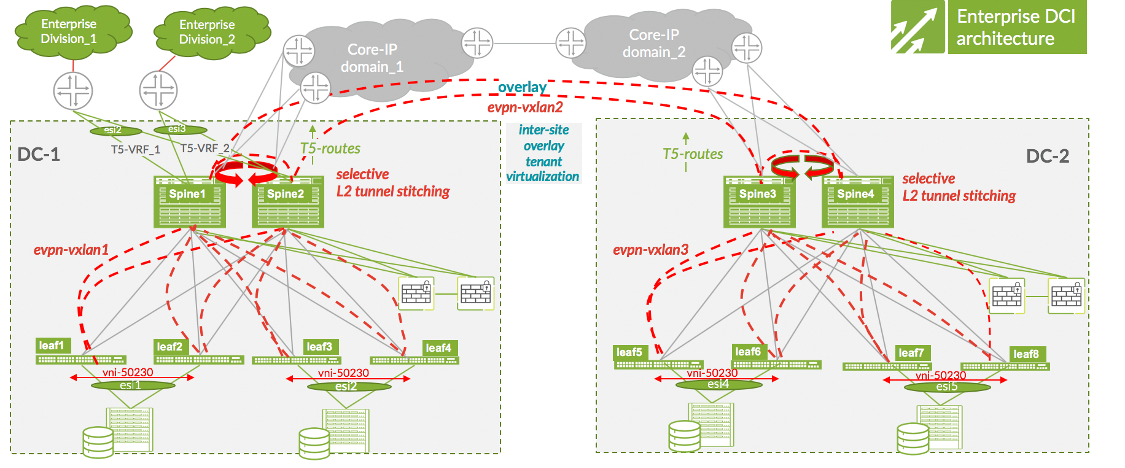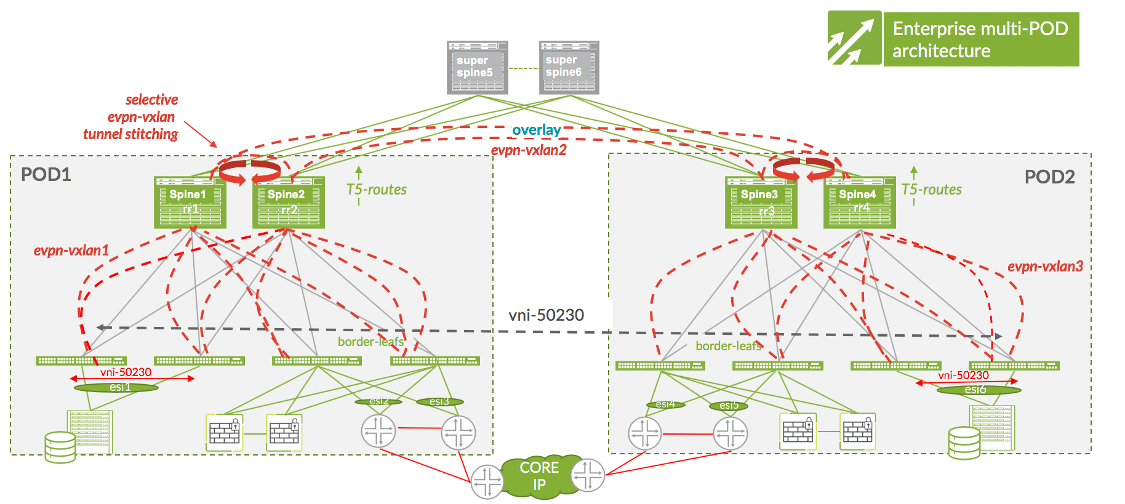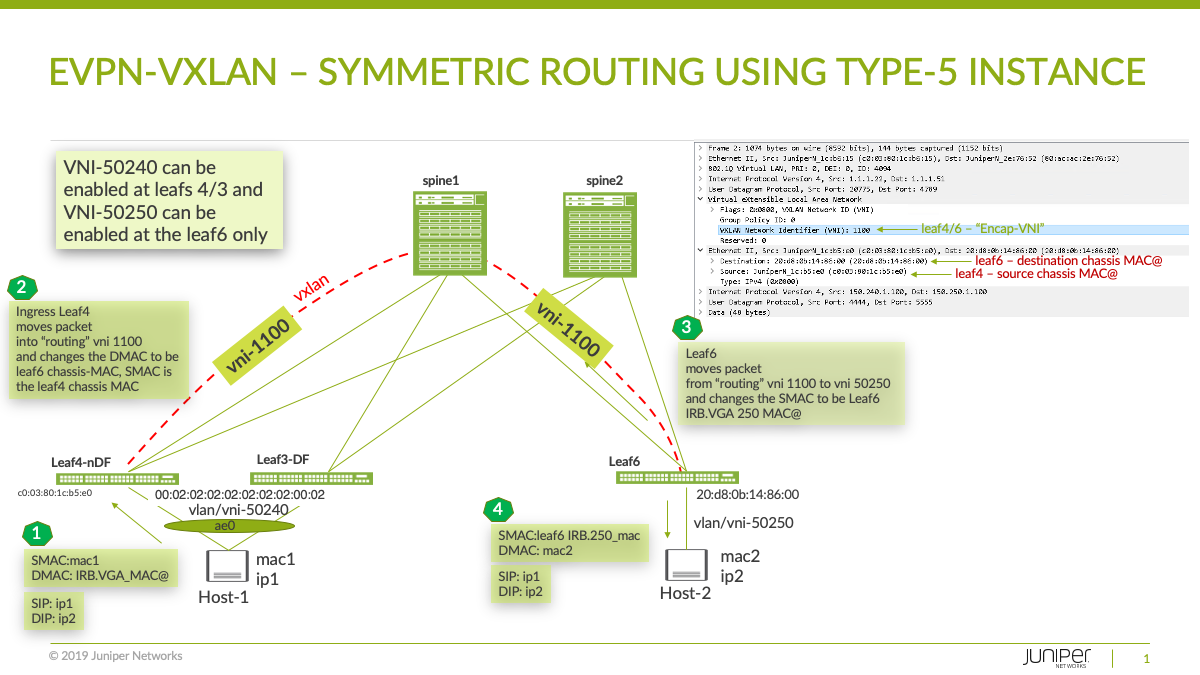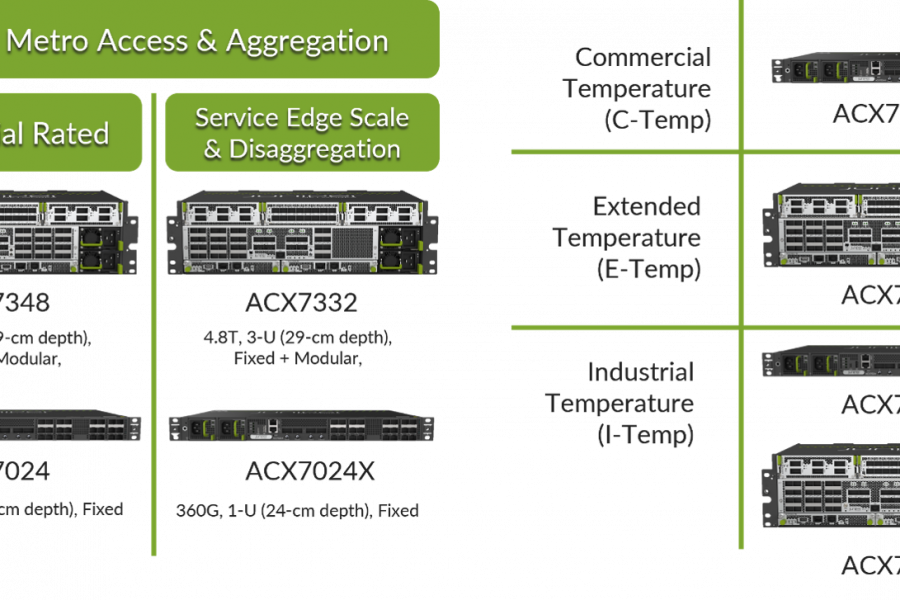This is the second in a series of seven blogs that focus on several areas of interoperability testing including Segment Routing, EVPN, SDN Controllers, Network Automation and Timing & Synchronization. The test report is publicly available and can be found here. See part one on segment routing here.
For over two decades, Juniper has pioneered Ethernet Virtual Private Network( EVPN) standards and deployed the technology in production networks for service providers and enterprises around the world. Traditionally, data centers used Layer 2 technologies including Spanning Tree Protocol (STP) and multichassis link aggregation group (MC-LAG) to connect compute and storage resources. EVPN is a powerful technology that can bridge the gap between the L2 connectivity of legacy applications and modern IP fabric architectures increasingly found in data centers, Data Center Interconnect (DCI), WAN, campus and metro domains.
Using EVPN-VXLAN, Juniper Networks is helping multi-national enterprises deliver network virtualization techniques created on top of the existing multi-domain IP legacy infrastructure in order to simplify multi-tenant and new multicloud data services connectivity. With IETF standards-based EVPN-VXLAN on Junos software, this can be achieved even when remote locations are located behind multiple IP domains or connected to different vendors supporting EVPN Type 2 (VLAN-aware bundle service) model or EVPN Type 5 (prefix advertisement) model. Benefits of an EVPN-VXLAN solution from Juniper include:
- Unified DC ecosystem – common EVPN protocol in the Campus, Data Center and DCI
- Additional overlay network virtualization options at the infrastructure and server level
- Various evpn service-types crossing existing IP multi-domain boundaries:
– Type T2: VLAN-aware, VLAN-based, VLAN-bundled and Type 5 for IP prefix advertisement - EVPN-VXLAN tunnels stitching capabilities for better control of multi-pod and multi-site DC scaling
- Comprehensive 10G/25G/100G/400G Ethernet data center and core-edge portfolio with QFX and MX family of products
- Juniper’s strong involvement in the IETF EVPN-VXLAN/EVPN-MPLS open standards
The EVPN interoperability testing at EANTC focused on two enterprise data center use cases:
- Enterprise Overlay DCI Architecture
- Multi-pod DC enterprise/Telco-DC architecture
Use Case #1: Enterprise Overlay DCI Architecture
The following topology shows two data center networks where the production department delivers server clustering between the sites and at the same time directly takes care of providing secure access to the data to the separate internal business groups by partitioning selected workloads at the L2 & L3 level VRFs and steering the selected traffic to the local site firewalls. When the application calls for internal disparate business groups, the remote DC already has the underlay connectivity to the solution which allows faster delivery of the DC services catalogue to the specific internal division or smaller remote DC.
DC-1 and DC-2 can be both supplied by Juniper and in that case more advanced features such as EVPN-VXLAN tunnel stitching can be used. Alternatively, DC-1 can be from Juniper and DC-2 from a different vendor – in this case EVPN Type 5 can be a good option for pure overlay connectivity of the workloads without the need to reprovision the existing core IP domains or ask other departments managing the core IP networks for additional tenant connectivity.

Use Case #2: Multi-Pod DC Enterprise/Telco-DC Architecture
The following diagram shows a multi-pod use case where POD1 and POD2 are interconnected using dedicated super spine devices instead of existing core IP links. In this case similar to the previous topology both pods an be from Juniper in order to benefit from more advanced features such as EVPN-VXLAN stitching or pure overlay multicast. Alternatively, POD2 could be from a different vendor supporting EVPN Type 5 routes or EVPN Type 2 VLAN-aware bundle service type.

Network engineering teams and architects with the standardized LAN DC and DCI solution are now getting more options to deliver faster connectivity. Additionally, in many cases the new EVPN-VXLAN overlays can be enabled dynamically based on server workload connectivity when using an advanced fabric management solution such as Contrail Enterprise Multicloud (CEM).
The recommended approach of using EVPN Type 5 routes for multi-vendor fabric environments is possible due to the fact that it has fewer dependencies on other EVPN route types and because most vendors have adopted precisely the same Type 5 route IP-VRF-to-IP-VRF interface-less service model.
Here’s another simplified example of the data packet walk used between Leaf4 from one vendor when sending the packet to Leaf6 from a different vendor.

Leaf4 gets the information regarding the Leaf6 chassis MAC@ to rewrite via the EVPN Type 5 route extended community. Therefore the other EVPN route types are not needed in order to have full communication between Host-1 and Host-2, as all the information is contained within the same route advertisement. This service model is a simpler way of interacting between different vendors and is also the most scalable approach for the data center fabrics or DCI from the RIB and next-hop perspective.
For Layer 2 stretched use cases of DC/DCI fabric interoperability, the Juniper recommended approach is to use the VLAN-aware bundle service model and ensure the ESI value Type 0 or 1 is being used in the system for multi-homing purposes.
Open and Interoperable
Juniper continues to invest in the development of advanced internetworking features in order to improve the way enterprise and telco DC network architects consume infrastructure resources. Some of the recent features introduced in Junos on QFX and MX products for building optimized overlay network infrastructure include:
- Pure overlay optimized multicast between pods or DC sites without the need for underlay PIM routing:
– Assisted-Replication
– SMET (EVPN route Type 6)
– EVPN route Type 7/Type 8 for multihoming - Overlay advanced EVPN policy-statements aka EVPN route-maps for improved administration
- Node and port level L2 ethernet VLAN-ID overlapping capabilities for easier common multi-tenant services identification
- Server and network infrastructure level EVPN protocol that integrates with Contrail vRouter, a fabric QFX switch and can talk to vRouter using common EVPN protocol signalization
- Junos serviceability for EVPN – advanced Junos configuration and troubleshooting toolset and telemetry
Juniper has demonstrated multi-vendor interoperability in two use cases at EANTC. These use cases demonstrate how a deployed Juniper core edge network infrastructure can be re-used for deploying pure overlay network infrastructure with minimal disruption. Juniper is commited to participate continuously in a variety of interoperability events in order to demonstrate that enterprises can easily introduce and integrate new solutions into their multi-vendor environments – from the software protocol interop including EVPN, SR and SDN (PCE,PCC/PCEP) to time precision or optical systems and ethernet IEEE standards.
In Part 3 of this blog series, we will explore the interoperability testing with respect to Segment Routing.
Join interactive breakout sessions exploring automated next-generation data center operations at our Juniper Virtual Summit for Cloud & Service Providers on June 10 (US/EMEA) and June 11 (APAC).


